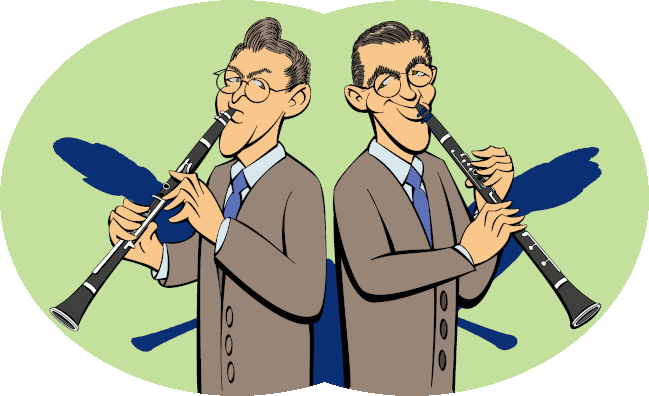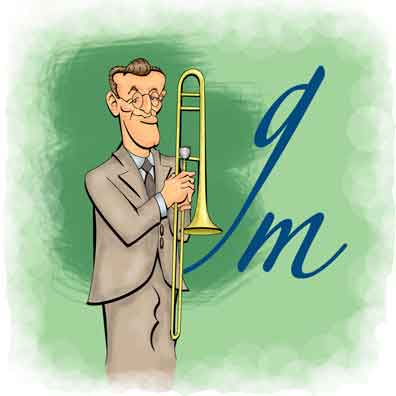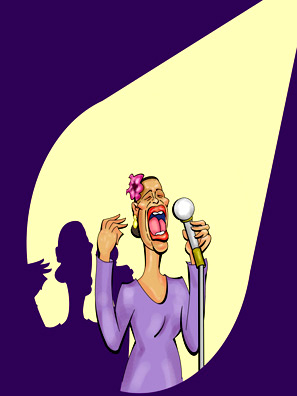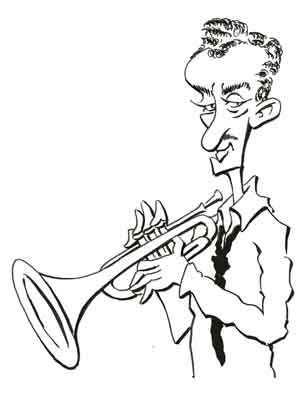Reel to Real 1
(Steve and Benny)
Footnote
Reel-to-reel is, for those born after the onset of the digital age, a type of recording device using magnetic tape where the blank tape is held on one reel and during the recording the tape is wound onto another reel of the same size. Reel diameter, tape width, and speed varied depending on the quality required and practical considerations regarding the equipment size and duration of the recording.

| Benny was a terrific leader, but if I’d had any spunk I’d probably have thrown the piano at him. | |
| - | Jess Stacey |
We have to admit it. Top jazz clarinetists don't enjoy quite the celebrity as pianists and trumpet players. If you ask Joe and Josephine Blow on the street, they'll probably struggle to think of even the likes of Pete Fountain or Artie Shaw - certainly not others like Buddy DeFranco or Pee Wee Russell. Part of the problem here is that some - "quote" - "great clarinetists" - unquote - are better known for playing other instruments, usually saxophone. In that group you have Jimmy Dorsey, Lester Young, Jimmy Guiffre, Art Pepper, and (of course) Sidney Bechet.
That said, even today the "King of Swing", Benny Goodman, remains the most famous practitioner of the instrument that Ian Fleming, the creator of James Bond, once labeled "an ill woodwind that nobody blows good". And Benny remains not just the most famous jazz clarinetist, but the most famous clarinetist period.
Benjamin David Goodman was born in 1909 in Chicago. He began playing professionally in 1923 and continued until the year he died, which was 1986. Although the family was poor, it was close knit. It had to be, Benny said, with two adults and ten kids living in a small apartment.
The family was what you might call of the working poor and in a day when mandatory education stopped at age fourteen, the kids were expected to get jobs in their early teens. Although that was the age that mandatory schooling ceased, in practice it could be much earlier. Benny's mom, Dora, had gone to work at age eight and never learned to read and write. David, his dad, rarely garnered more than $20 a week for tasks that ranged from shoveling in the Chicago stockyards to working at a newsstand.
But this was America and David wanted something better for his kids. One night he heard some music from a neighboring apartment. On inquiring he learned that the kids in the family were going to high school where they were learning to play the instruments. Still better, they were picking up some extra money playing for various social events. When David took his family to a concert, they saw kids were sitting in the orchestra.
David decided that his sons should study music and enrolled them in the Kehelah Jaboc Synagogue music program. There was no fee for using the instruments and private lessons could also be arranged for modest cost.
The instruments assigned to the Goodman kids were based on their size. The oldest and biggest, Harry, learned trombone and tuba. Freddy, the next one down, played trumpet, and it was the smallest, Benny, who got the clarinet. But from the first it was clear Benny had the talent.
When the synagogue band had to be discontinued in 1920 due to financial pressures, David made sure Benny and the others continued their lessons with a band organized at Hull House. Hull House was founded by Jane Addams in 1889 to stop kids from believing that crime paid well enough. And yes, Benny's neighborhood was a rough one. But Benny and his brothers joined the band and in winter their dad would haul them to their rehearsals on a sled.
So a lot of credit to Benny's success has to be given to his pop. True, being a musician was a practical way to make a living in a day when good music had to be live music. So the idea of having professional musicians in the family wasn't a starry eyed pipe dream. Certainly David was willing to make sacrifices so his sons could have better opportunities than he ever had. Besides, he loved music.
Of course, the music they played in the synagogue and at Hull House was highbrow classical stuff. But jass (as it was first spelled) was becoming the rage and Benny's introduction to this genre came when he heard the tinny scratchy recordings of Ted Lewis - later famous for his "Me and My Shadow" routine with Eddie Chester - play the clarinet. Soon he was able to copy Ted's "hot" style note for note. Then he entered a local "Amateurs Hour". He played so well that when a professional act canceled out later that week, the theater owner went to look for Benny who he found in the streets playing hockey.
Benny ran home and grabbed his clarinet. At the theater he played "I Never Knew", "St. Louis Blues", and the Ted Lewis tune "When My Baby Smiles at Me". When he finished the crowd went wild. Benny later said he liked the applause but the five bucks he got paid was better.
So at age eleven Benny was playing professionally. But he kept taking lessons at Hull House and he also studied with the clarinetist Franz Schoepp who was the clarinetist with the Chicago Symphony. Within two years Benny was a true virtuoso.
One of Benny's friends in high school was trumpet player Jimmy McPartland. Jimmy had developed an acute business sense even then and could dredge up gigs for him and other aspiring musicians. Jimmy, Benny, and others of his musical gang might play four nights a week at dances or other social functions and sometimes they might haul in munificent sums as high as $15! Jimmy had trouble convincing his mom that the money really had come from just playing music.
By age 14 Benny was playing in local dance orchestras where he met a number of soon to be famous musicians. While sitting in with Bill Grimm, he met Bix Beiderbecke who is now credited as one of the founders of "Chicago Style" jazz. Making real money playing music? It seemed to good to be true.
Benny's first real job as a full time professional musician was in the band led by drummer Ben Pollack. Pollack was a pretty big name and he had heard Benny play some of the Ted Lewis numbers. So in 1925 he told Benny if he wanted a job he had it. The pay - $100 a week - was fabulous. Not bad for someone who just a few years earlier was wearing short pants. Benny soon told his dad that he could quit his jobs and let Benny support the family. David, a man of immense pride, told Benny he could take care of himself.
The band not only played at swank Chicago hotspots like the Broadmoor Hotel but they also toured, even going to Hollywood. Pollack had also hired a young Glenn Miller as his trombone man, although he didn't really think that much of Glenn's playing.2
Footnote
Glenn himself seems to have tacitly acknowledged he wasn't technically on par with others of the players, including those in his own band. One thing that gradually dawns on all fans of the Big Bands is you never see Glenn take a solo. Far different from seeing films of Tommy Dorsey, Harry James, Artie Shaw, and Benny Goodman. The only example of Glenn ripping off on his own is in the film Orchestra Wives where he only plays a few notes.
Of course on the recordings you can't be sure a trombone passage is Glenn's playing or another from the trombone section. One example which is sometimes claimed to be Glenn strutting his stuff is the 1926 cylinder recording of "Sobbin' Blues" led by trumpet player Earl Baker. Earl had borrowed some of Ben Pollack's band to cut the record.
Yes, there is a trombone on the recording and it is Glenn. But what some say is a "trombone solo" is really Fud Livingstone on saxophone (you can even hear Glenn's trombone in the background). But there is definitely a solo by - yes - Benny Goodman.

Glenn Miller
Bennie's Fellow Bandmember
In music full time playing isn't always full time and in addition to performing with Pollack, Benny would pick up money as an independent session musician. He'd backup vocalists for recordings and on radio broadcasts as well as in musicals. Many of the greatest stars of later years started off as session players including Jerry Reed, Glenn Campbell, and Leon Russell.
Then in 1926 and unexpectedly, tragedy struck. After working at his newsstand, David stepped out into the street and was struck by a hit-and-run driver. He died the next day and now Benny and his brothers were the main support of his mom. Fortunately at age 17, Benny was not only in fine financial form but he was was able to help out his sister when her husband was seriously injured in a traffic accident that was eerily akin to the one that had killed his dad.
Benny moved to New York City which was still yet the center of entertainment. Benny had made his first recording "He’s the Last Word" while in Pollack's band and by 1931 Benny he well enough known to issue his own records. His first recording under the Benny Goodman name was "He's Not Worth Your Tears" and he was soon noticed by the recording executive John Hammond.3 They began working together in 1933 and the next year Benny landed a contract with Columbia Records. His "Ain't Cha Glad?" (with trombonist Jack Teagarden providing vocals) reached #1 on the charts.
Footnote
John had a remarkably long career and promoted the careers of many of the 20th century's musical superstars. Among some of John's "discoveries" were Count Basie, Charlie Christian, Aretha Franklin, Harry James, Bruce Springsteen, Billie Holiday, Pete Seeger, and future Nobel Laureate Robert Allen Zimmerman.
All of this happened, we must remember, before Benny had a band of his own. But he knew if you wanted to bring in the really big dough that's what you needed. So in 1934 Benny recruited some top-flight musicians and the Benny Goodman Band became regulars on the radio program Let’s Dance. They proved popular and Benny was able to land them a stint at the prestigious Los Angeles Palomar Ballroom.
There on August 21, 1935 everyone was expecting great things from the new star. But as often happens their initial playing wasn't that great. At least not as good as the audience expected. Well, if they were going to flop, they might as well flop playing some stuff they liked. Benny pulled out some new arrangements and they let 'em rip. The crowd went wild. From then on, Benny was the King of Swing and some scholars cite this date as the beginning of the Swing or Big Band Era.
Then in 1938 Benny and his band played in, yes, Carnegie Hall. Jazz had finally become respectable. Jazz, the fans said, was an art, and "Take the A-Train" was equal in prestige to Brahms's Piano Concerto #1. So instead of playing in nightclubs, the big bands began to appear in concerts before the sit-down audiences. Other jazzists like Artie Shaw and Glenn Miller soon followed in the Hall Where Tchaikovsky Conducted. "Jazz bands don't belong in ballrooms or hotel grills," pianist Stan Kenton said in 1947.
Ironically, the achievement of respectability and the demand for respect may have been what led to jazz's decline. After all, you can't appear at Carnegie Hall five nights a week for two months. And arranging prestige concerts was time consuming and expensive. For what it's worth Stan's quest for respect never worked out and by the 1970's, he was playing at the Lancer Steak House in Schaumberg, Illinois.
One area where Benny really left a legacy was his philosophy of integrated bands. Even as late as the 1960's having black and white musicians in the same band was a matter of controversy. But Benny was impatient with clubs that forbade "mixed" bands, and in the 1930's Benny would hire and perform with African American musicians like pianist Fletcher Henderson, vibraphonist Lionel Hampton, and guitarist Charlie Christian. Not that this didn't take some creativity. One trick (particularly when they played in the South) was to start off with only white players on stage but then bring the black musicians in as the show progressed as if they were "special guests". And of course, Benny recorded with Billie Holiday a number of times.

Billie
Unlike some superstars (like Harry Houdini), Benny didn't worry about competition and even seemed to welcome it. In fact, he would bankroll it. In 1937 Benny had hired a young trumpet player named Harry James who soon became not only the band's principal horn man, but would sometimes stand in on drums (Benny could have trouble keeping drummers after Gene Krupa left). More importantly if Benny wasn't able to make a performance, Harry would take over as leader. Then in 1939 when Harry decided to start his own band, Benny put up some money to help Harry get started.

Harry James
The Welcome Competition
The beginning and endings of historical epochs are sometimes hard to pin down. But the Swing Era began, as we said, on August 21, 1935. And it ended almost exactly ten years later, on September 2, 1945.4 That is, at the close of World War II. So by this reckoning, the only time that popular music had the approbation of both adults and their kids lasted maybe 10 years.
Footnote
Some scholars may put the beginning of the Big Bands as early as the 1920's and extend it to around 1947. Not to say there weren't Big Bands after World War II - they're still around today - but the truth is the era was over after the war as post-war economics pushed jazz toward smaller combos and the musicians - the Be-Boppers - ensured the music became less mainstream. Today jazz accounts for less 1% of the music performed.
Naturally, Benny just didn't pull up and quit the business. He kept the band going and kept playing and touring until 1986. But he did - somewhat regretfully - adopt modern tunes to his band, one of which was - no joke - the Beatle's tune, "Rocky Raccoon".
By the mid-1950's the Swing Era was part of history. So what could be more fitting than a movie, yes, a movie, about the King of Swing and how he brought in a whole musical genre? Universal Studios agreed and in 1956 released The Benny Goodman Story.
The choice of the star might seem a bit odd. The studio picked comedian Steve Allen who had been hosting The Tonight Show since 1953. But it did make some sense. Although Steve was known for his somewhat off-beat humor, he was a musician and composer himself.
With the usual caution of the show being a "bio-pic" which is subject to scriptwriters' whims, it's not a bad movie. Steve does a creditable acting job and he has a good resemblance to Benny5. The music is great - which it should be since the clarinet playing is actually Benny dubbing in.
Footnote
One thing that is noticeable is that in the film Steve's face appears longer and thinner than usual, further enhancing his likeness to Benny. Whether this effect was achieved without artificial means isn't clear. But there definitely seems to be a difference from Steve's Goodman-esque appearance in the movie and that of his television shows from the same or earlier times.
Benny's wife, Alice, was played by Donna Reed who would later star in her own show as the quintessential American 50's and 60's housewife. The real Alice was in fact the daughter of John Hammond who you'll remember was important in furthering Benny's career. One facet of the relationship that Hollywood omitted is that when Steve and Alice first became, well, interested in each other, she was still married to her first husband and had two kids. Such a characteristic, of course, had to be tactfully skimmed over in a 1956 movie.
The movie, though, did not ignore Benny's attitude that music knows no color and we see him performing with black musicians. And starring as Fletcher Henderson was none other than Sammy Davis, Sr. Yes, that's Sammy Davis, Sr., the father of the junior Sammy Davis.
You'll find some commentary on the film's accuracy. Sure, some movies like to add a bit of drama and so scriptwriters happily dream up embellishments even if they more or less stick to gist of the story. Such a treatment was particularly noticeable in The Five Pennies starring Danny Kaye, a movie about the life of Red Nichols, a trumpet player and band leader who Benny had played for in his early career.
The part of the story where Red's daughter, Dorothy, contracts polio is based on fact. However, she was never in an iron lung, nor was it only when she was in her mid-teens that she learned her dad had been a famous trumpet player.
And yes, Red did quit the music business but not in remorse for Dorothy's illness and he certainly didn't throw his trumpet off the Golden Gate Bridge. And the real Red did work in a shipyard but not - as the movie implies - for more than a decade.
Instead Red had quit the music business in 1942 after playing a stint in Ohio and well before Dorothy's bout with polio. Some say he quit because the war made it hard to recruit top notch musicians; others that he wanted to contribute directly to the war effort. Dorothy herself said he hadn't like the poor bookings he had been getting. It was probably such a combination of ingredients that made a change or at least pause in Red's career seem sensible.
In any case the movie's chronology is all wrong. Red began his performing hiatus in early 1942 and Dorothy was stricken in June 1943. Only a month later, a booking agency asked Red to come back to performing. He didn't respond to that query but by November, Downbeat magazine reported that Red was planning a return. Only three months later, in February 1944, Red was back playing his trumpet in Chicago and he continued as a professional musician until his death in 1965.
Benny knew that to make sure his band produced the best music possible he had to hire, well, the best musicians possible. The band members in turn remembered Benny as a great musician but as quite a - well, let's just say Benny could be an exacting taskmaster.
The problem with being the best in the world leading a group that are the best in the world is you really can't tell the others that are the best in the world how to do things better. But that doesn't mean you won't try.
And if you want to be a perfectionist you better be perfect yourself. Otherwise your employees may take great delight in "straightening things out" by relating (what are to them) amusing anecdotes. Even Benny, they would point out, could flub a solo.
Given that Benny became quite wealthy it's no surprise that he was meticulous in accounting debits and credits. And he rarely gave away anything for free. When he took his band on a tour of Russia in 1962, he called up Clifton Daniel, the Moscow Bureau Chief of the New York Times (and husband of Margaret Truman), for advice on what preparation he needed to do. Clifton said jazz albums were rare in Russia and if Benny would send some of his albums, he'd make sure they got to some Russian libraries so the citizens could get exposed to the music beforehand. Benny thought that was a great idea and sent Clifton a goodly supply of his records. He also sent Clifton a bill for the albums, a bill which eventually the Times paid.
On the other hand, if Benny wanted a particular player he'd pay top dollar. Although it was sometimes a challenge working for him, pianist Teddy Wilson said you just had to ask for enough money to make it worth your while. If a valued player was reluctant to leave their family for a long tour, Benny would tell him to bring them along.
Benny also had an eccentricity that when he was about to start a number with the instruments in place and embouchures set, he'd just stand there with his eyes closed and hands raised. Sometimes he'd wait nearly a minute - which is a long time for nothing to happen on a stage. Then he'd kick off the tune. No one ever figured out what this was about.
Seemingly Benny accepted the truism that leaders shouldn't get too familiar with the troops, and he tended to keep to himself even to the point of staying at different hotels than the rest of the band. On the other hand, he would borrow reeds from the other players, bum their cigarettes, and if he joined them for lunch, he'd let them pay the bill. Such courtesies extended beyond the band. Once he bumped into a musical acquaintance and his wife on the street and invited them to dinner. As they finished the meal, Benny said he had to make a phone call. He got up and left, leaving the couple to pay the whole tab themselves.
References and Further Reading
Swing, Swing, Swing, Ross Firestone, Norton, 1994.
"Benny Goodman", Encyclopedia of World Biography.
"Benny Goodman", William Ruhlmann, AllMusic.
"Benny Goodman", Discography of American Historical Recordings, University of California - Santa Barbara.
"The Benny Goodman Quartet", 64 Quartets.
"35 Years Since the Death of Benny Goodman, the 'King of Swing'", Susan Hall, Debate Post, June 13, 2021.
"Benny Goodman: Forever The King Of Swing", National Public Radio Weekend Edition, May 30, 2009.
"Swing Era of Jazz Began at L.A.'s Palomar Ballroom", Kevin Roderick, LA Observed, August 21, 2010.
"Jazz Has Become The Least-Popular Genre In The U.S.", David La Rosa, Jazzline News, March 9, 2015.
The Benny Goodman Story, Steve Allen (actor), Donna Reed (actor), Herbert Anderson (actor), Sammy Davis Sr. (actor), Valentine Davies (director), Valentine Davies (writer), Aaron Rosenberg (producer), Universal, 1956, Internet Movie Data Base.
"To Russia Without Love", Bill Crowe, Gene Lees Jazz Letter, August - November, 1986 (Reprinted: BillCrowBass.com).
The Red Nichols Story: After Intermission 1942-1965, Linda Evans, Scarecrow Press, 1997.
Live and Let Die, Ian Fleming, Jonathan Cape, 1954